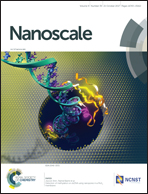Hierarchical thermoplastic rippled nanostructures regulate Schwann cell adhesion, morphology and spatial organization†
Abstract
Periodic ripples are a variety of anisotropic nanostructures that can be realized by ion beam irradiation on a wide range of solid surfaces. Only a few authors have investigated these surfaces for tuning the response of biological systems, probably because it is challenging to directly produce them in materials that well sustain long-term cellular cultures. Here, hierarchical rippled nanotopographies with a lateral periodicity of ∼300 nm are produced from a gold-irradiated germanium mold in polyethylene terephthalate (PET), a biocompatible polymer approved by the US Food and Drug Administration for clinical applications, by a novel three-step embossing process. The effects of nano-ripples on Schwann Cells (SCs) are studied in view of their possible use for nerve-repair applications. The data demonstrate that nano-ripples can enhance short-term SC adhesion and proliferation (3–24 h after seeding), drive their actin cytoskeleton spatial organization and sustain long-term cell growth. Notably, SCs are oriented perpendicularly with respect to the nanopattern lines. These results provide information about the possible use of hierarchical nano-rippled elements for nerve-regeneration protocols.



 Please wait while we load your content...
Please wait while we load your content...